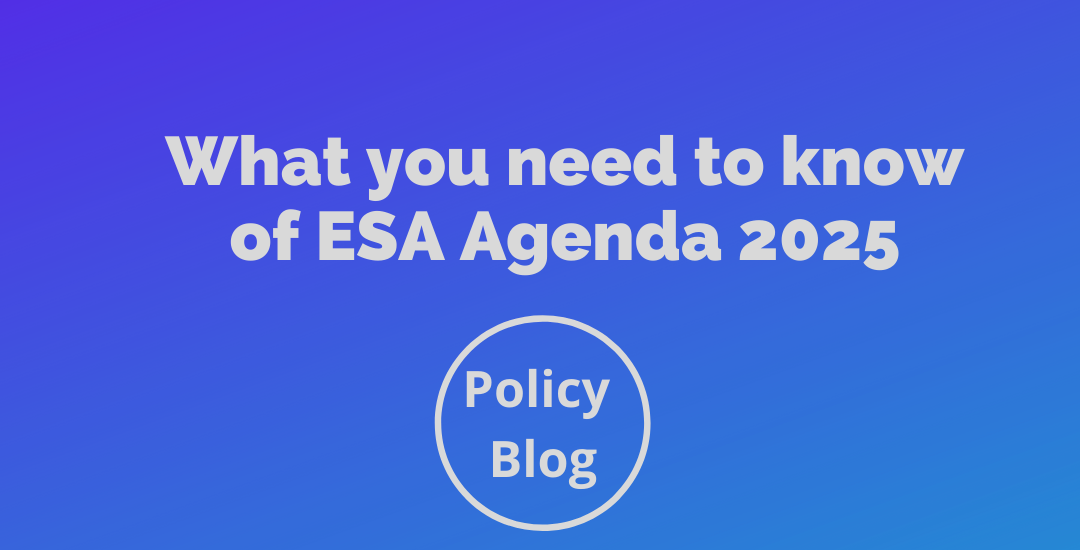- May 17, 2021
- Posted by: EARSC
- Categories: Blogs, European EO Industry, Policy Blog

By Aaron Scorsa
The 7th April 2021, Josef Aschbacher, the newly appointed Director General of the European Space Agency, has presented ESA Agenda 2025. In this document the new head of ESA presents the strategy of the agency for the next four years with the aim of competing with the United States of America and China. During the press conference, Mr. Aschbacher highlighted the most important features of the 17 pages document by outlining the purposes, its creation and its intentions. He remarked several times that ESA Agenda 2025 is an inclusive document as all the ecosystem has to understand these high-level visions. Moreover, the History clock of Space is showing us through the oscillations of the pendulum that we are in the middle of an historical crossroad, between the irruption of private actors in the “New Space” and the rise of new nations in the sector.
This is why, in these challenging times, the document settles the basis with 5 priorities with targets for 2025 and with Common European Space Vision for 2035.
ESA priorities for 2025
As we know, all type of space activities is facing rapid and incessant evolution worldwide. In fact, the ambitions to meet the goals for a green, digital, safe and inclusive Europe need a clear and pragmatic preparatory phase. To face the challenges for the next four years with this starting document, five priorities are identified in the ESA Agenda 2025, respectively:
- Strengthen ESA-EU relations
- Boost commercialisation for a green and digital Europe
- Strengthen space safety and security
- Address programme challenges
- Complete the ESA transformation
Strengthen ESA-EU relations
In the first pillar, it is stated that Europe in space is not just ESA, but all actors involved in the process which are ESA Member States, the European Commission and the private companies.
The joint statement of Thierry Breton and Josef Aschbacher in which “EU and ESA must, and will, work hand in hand to make sure we are responding to the challenges ahead of us” underline the importance of improving cooperation. In fact, the political leadership provided by the Commission is extremely relevant for societal needs as Copernicus and Galileo, this is why ESA aims at the creation of new space projects.
Boost commercialisation for a green and digital Europe
The New Space approach has changed the market leading to lower prices, innovative services and products with new players. Here, the main objective is to bridge the growing space economy by an improved interaction with the private sector with greener and digital economic tools.
ESA is aiming to do that fulfilling three challenges, as follows:
- The challenge is to offer European talent attractive opportunities with in European to adapt higher education curricula to the skills required for the future
- The second challenge, access to capital, requires efforts in two domains: creating sufficient public demand, and ensuring easy access to capital from investors
- To speed up innovation cycles, the third challenge, ESA will create an integrated and agile framework for innovation
Strengthen space safety and security
ESA is willing to become the “natural technical partner at European level for developing space infrastructure and security purposes”. Here it is affirmed that data from space is vital for many different activities in which ESA is already involved as weather forecasts or communications. This is why ESA is eager to improve and work with Member States safety and security in space in continuation of past achievements.
Address programme challenges
The main challenges to address in the future regard launchers, operations, applications, science, exploration and technology. More specifically: enable technology for driverless vehicles and smarter cities, Moon and Mars missions, science exploration and technology development as machine learning, big datasets and quantum technology.
Complete the ESA transformation
Here, it is explained the internal changes that ESA will continue to make in coordination with the Member States. The aim is to include all sectors of societies and respects the resources of the Earth.
Here, as EARSC, we could also mention the agreement on the settlement of performance indicators linked to ESA procurement for Earth Observation programmes which are fundamental for the EO industrial community.
Next steps
In order to translate these priorities into reality Europe has to reach a common understanding. This it would be possible by a political process and strong stakeholder interaction for the development of a common European space vision and ambition.
In the next months to start this process concretely:
- 2021 Pan-European political process with the Intermediate Ministerial Meeting 2021
- 2022 Space Summit with New Flagships programmes and evolving governance
- 2022 ESA Ministerial Council
